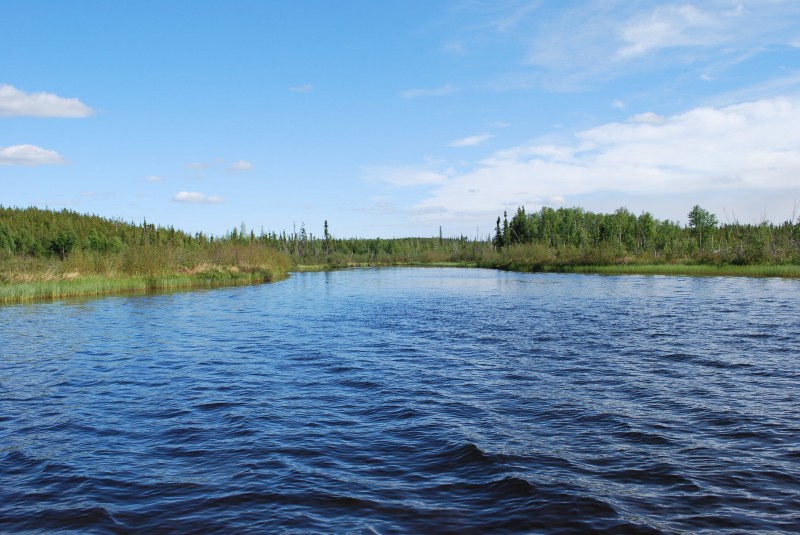
FRANKFORT, Ky. – Floating a stream and catching smallmouth bass after smallmouth bass, a few spotted bass, rock bass, green sunfish and even an occasional white crappie is the one of the best ways to spend a summer afternoon. On a blistering hot day, you can beach your boat, wander out into a flowing, shallow shoal and sit down, letting the cool water of the stream flow over you and wash away the sweat and heat.
A personal pontoon boat, sometimes called a cataraft or a float boat, is an affordable entry into floating the wealth of streams that flow in Kentucky. A pontoon boat consists of two pontoons lashed onto a steel or aluminum frame with oars mounted on the frame. Some newer models don’t have frames, but use air pressure and specially designed pontoons to ensure the boat’s structural integrity.
Boats such as these along with kayaks and canoes are growing rapidly in popularity as the cost of motorized, lake and river worthy boats continues to rise beyond the budget of many people. You can pick up a good new pontoon boat for under $500 from one of the national outfitters or find a used one on the Internet for much less.
Operating a canoe or kayak requires more practice and skill than using a pontoon boat, but these boats possess their own idiosyncrasies that users should know before trying one out on a Kentucky stream.
First, don’t buy one with cloth covers on the pontoons if you plan to float the rocky streams of Kentucky with any regularity. The rough limestone underlying a great extent of the state or the sandstone of the mountainous region does a number on cloth after a few floats.
You can baby them for quite a few years if you don’t use your boat much, but opt for pontoon covers made of PVC for stream fishing. If you plan to mainly float lakes or riffle-free, slow moving rivers, the cloth covers are fine and cost less than PVC.
Secondly, don’t bite off more stream than you can chew. A personal pontoon boat is not a canoe or kayak. With one of these boats, you sacrifice the speed of a canoe or kayak for a stable fishing craft that moves the same speed as the current, giving the fish (especially smallmouth bass and trout) a realistic lure presentation. You also can’t row upstream against current much distance with a pontoon boat like you can a kayak. There is no bailing out by going back to the put-in once you commit to a float.
Plan floats for six miles or less if you start early and fishing is your goal. You can stretch a pontoon boat excursion up to seven miles with high water. You can also cover that much water if you plan to mainly float and casually fish.
Around five miles is the ideal float length for extensive fishing without any worry. A common mistake made while floating a stream is spending too much time fishing at the beginning of the float and then paddling in a panic to make the take-out by dark. Avoid floating in darkness at all costs.
At night, you can’t see obstructions in the stream and you can’t read rapids either. Night floating is a dangerous situation that brings serious injury and major boat damage into play. You don’t want to be walking a wounded boat home along the banks of a rock-strewn stream at 10 p.m. It is also easy to float right past take-out into a world of trouble at night. Start paddling when the shadows grow long and sunlight dims to make the take-out by dark.
Always bring along the hand pump that comes with your pontoon boat. Sometimes, a poor seal on the valve where you pump air into the pontoon bladder will slowly leak air during the float. Tightening the valve and a few pumps of air will usually solve the problem. Pontoons rarely fall victim to a piece of sharp metal or glass in the stream, but if you get a puncture, you’ll need your pump to get you home. Some models of these boats have a bladder inside a bladder pontoon design, so if you puncture the outside bladder, you’ll still get home. They cost more than single pontoon designs.
Navigating water in a pontoon boat is a bit different than floating in a canoe or kayak. Pontoon boats are incredibly easy to navigate through rapids, standing waves and other rough water. They are nearly impossible to flip, but avoid going down rapids sideways. You can pin the boat in the current against a rock and lose the ability to navigate with your oars.
In a pontoon boat, try and deflect off standing waves with one of the pontoons. Water flowing fast over a boulder or other obstruction creates a standing wave. Don’t straddle the waves with your pontoons or the standing wave will break on you. Big ones can knock you out of the boat, while smaller standing waves can cause the loss of fishing rods and equipment.
Pontoon boats quickly react to oaring, so don’t overuse them. A couple of quick, short strokes of the oars are all you need to straighten the boat. Make sure to balance the frame on the pontoons as well. Balancing the frame keeps the boat from riding too high in the front and submerging the back of the boat. This also keeps the boat from plowing the water when you oar by having too much weight toward the front.
Pontoon boats offer an affordable way to enjoy overlooked stream fishing opportunities in Kentucky. Use them in the right way and you’ll have years of fun and land hundreds of fish. Plus, they burn no gasoline in the process.
Lee McClellan
 Your Privacy Choices
Your Privacy Choices
 The
The